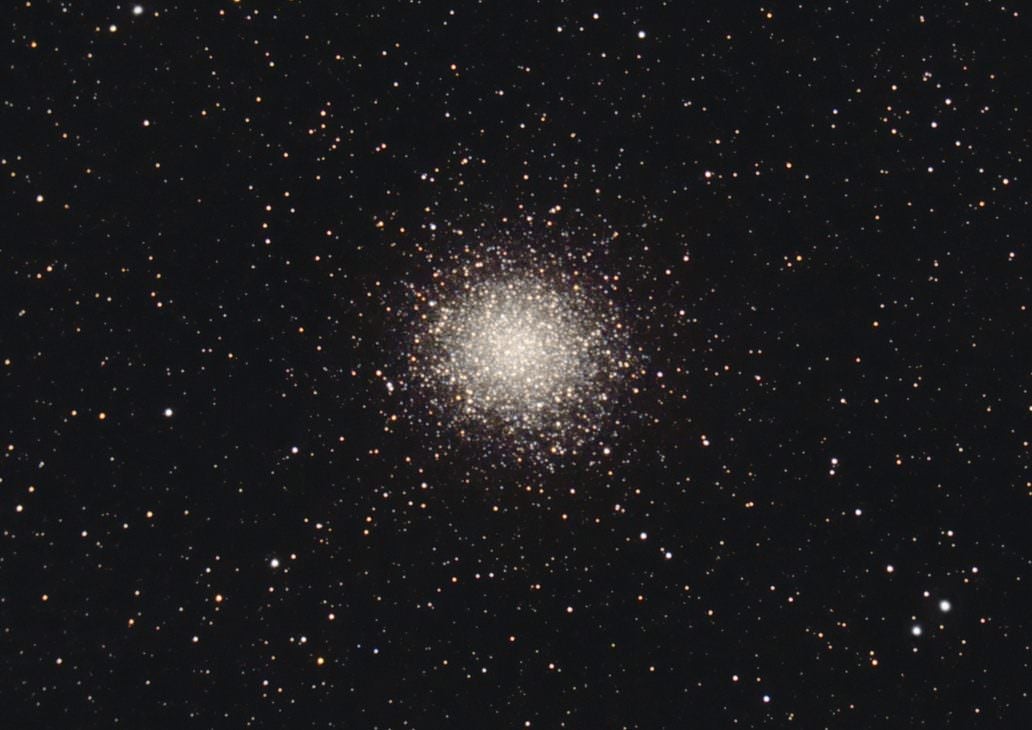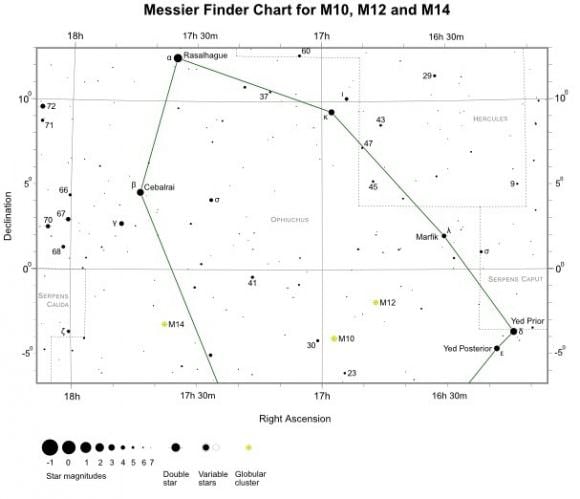Welcome back to Messier Monday! Today, in our ongoing tribute to Tammy Plotner, we take a look at the M14 globular cluster!
In the 18th century, French astronomer Charles Messier began cataloging all the "nebulous objects" he had come to find while searching the night sky. Having originally mistook these for comets, he compiled a list these objects in the hopes of preventing future astronomers from making the same mistake. In time, the list would include 100 objects, and would come to be known as the
Messier Catalog
to posterity.
One of these objects was the globular cluster which he would designate as M14. Located in the southern constellation Ophiuchus, this slightly elliptically-shaped stellar swarm contains several hundred thousand stars, a surprising number of which are variables. Despite these stars not being densely concentrated in the central region, this object is not hard to spot for amateur astronomers that are dedicated to their craft!
Description:
Located some 30,000 light years from Earth and measuring 100 light years in diameter, this globular cluster can be found in the southern Ophiuchus constellation, along with several other Messier Objects. Although it began its life some 13.5 billion years ago, it is far from being done changing. It is still shaking intracluster dust from its shoes.
[caption id="attachment_128145" align="aligncenter" width="580"]
The constellation Ophiuchis. Credit: iau.org
[/caption]
What this means is that M14, like many globular clusters, contains a good deal of matter that it picked up during its many times orbiting the center of our Galaxy. According to studies done by
N. Matsunaga (et al)
:
Another thing that makes Messier 14 unusual is the presence of CH stars, such as the one that was discovered in 1997. CH stars are a very specific type of Population II carbon stars that can be identified by CH absorption bands in the spectra. Middle aged and metal poor, these underluminous suns are known to be binaries. Patrick Cote, the chief author of the research team that discovered the star, wrote in their
research report
to the American Astronomical Society:
[caption id="attachment_129522" align="aligncenter" width="580"]
M14 Globular Cluster. Credit: tcaa.us
[/caption]
History of Observation:
The first recorded observations of the cluster were made by Charles Messier, who described it as a nebula without stars and catalogued it on June 1st, 1764. As he noted in his catalog:
In 1783, William Herschel observed the cluster and was the first to resolve it into individual stars. As he noted, "With a power of 200, I see it consists of stars. They are better visible with 300. With 600, they are too obscure to be distinguished, though the appearance of stars is still preserved. This seems to be one of the most difficult objects to be resolved. With me, there is not a doubt remaining; but another person, in order to form a judgement, ought previously to go through all the several gradations of nebulae which I have resolved into stars."
As always, it was Admiral William Henry Smyth who provided the most lengthy and detailed description, which he did in July of 1835:
[caption id="attachment_129518" align="aligncenter" width="580"]
Finder Chart for Messier 14 (also showing M10 and M12). Credit: freestarcharts.com
[/caption]
Locating Messier 14:
Messier 14 can be found by first locating Delta Ophiuchi, which M14 is located at about 21 degrees east and 0.4 degrees north from. It can also be found about one-third of the way from Beta to Eta Ophiuchi. If you know where Messier 10 is, take a look 0.8 degrees north and 10 degrees east of it to find M14. The cluster can also be located along the imaginary line from Cebalrai, an orange giant with an apparent magnitude of 2.76 and the fifth brightest star in Ophiuchus, to
Antares
, the bright red supergiant located in
Scorpius
.
With an apparent magnitude of +7.6, M14 can be easily observed with binoculars. For those using small telescopes, the bright center and faint halo can be viewed, whereas 8-inch instruments will reveal the cluster's elliptical shape. To resolve individual stars, you will need a 12-inch telescope or larger. The best time of year to observe the cluster is in the months of May, June and July.
And here are the quick facts for Messier 15, for your convenience:
- Object Name
-
Messier 14
- Alternative Designations
-
M14, NGC 6402
- Object Type
-
Globular Cluster
- Constellation
-
Ophiuchus
- Right Ascension
-
17 : 37.6 (h:m)
- Declination
-
-03 : 14 (deg: m)
- Distance
-
30.3 (kly)
- Visual Brightness
-
7.6 (mag)
- Apparent Dimension
-
11.0 (arc minutes)
We have written many interesting articles about Messier Objects here at Universe Today. Here's Tammy Plotner's
Introduction to the Messier Objects
, ,
M1 – The Crab Nebula
,
M8 – The Lagoon Nebula
, and David Dickison's articles on the
2013
and
2014
Messier Marathons.
Be to sure to check out our complete
Messier Catalog
. And for more information, check out the
SEDS Messier Database
.
 Universe Today
Universe Today



